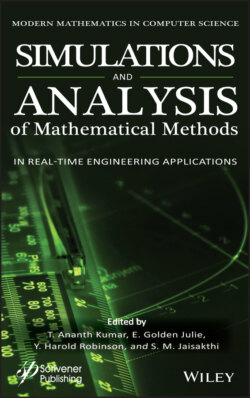Читать книгу Simulation and Analysis of Mathematical Methods in Real-Time Engineering Applications - Группа авторов - Страница 2
Table of Contents
Оглавление1 Cover
2 Title page
3 Copyright
4 Preface
5 Acknowledgments
6 1 Certain Investigations on Different Mathematical Models in Machine Learning and Artificial Intelligence 1.1 Introduction 1.2 Mathematical Models of Classification Algorithm of Machine Learning 1.3 Mathematical Models and Covid-19 1.4 Conclusion References
7 2 Edge Computing Optimization Using Mathematical Modeling, Deep Learning Models, and Evolutionary Algorithms 2.1 Introduction to Edge Computing and Research Challenges 2.2 Introduction for Computational Offloading in Edge Computing 2.3 Mathematical Model for Offloading 2.4 QoS and Optimization in Edge Computing 2.5 Deep Learning Mathematical Models for Edge Computing 2.6 Evolutionary Algorithm and Edge Computing 2.7 Conclusion References
8 3 Mathematical Modelling of Cryptographic Approaches in Cloud Computing Scenario 3.1 Introduction to IoT 3.2 Data Computation Process 3.3 Data Partition Process 3.4 Data Encryption Process 3.5 Results and Discussions 3.6 Overview and Conclusion References
9 4 An Exploration of Networking and Communication Methodologies for Security and Privacy Preservation in Edge Computing Platforms Introduction 4.1 State-of-the-Art Edge Security and Privacy Preservation Protocols 4.2 Authentication and Trust Management in Edge Computing Paradigms 4.3 Key Management in Edge Computing Platforms 4.4 Secure Edge Computing in IoT Platforms 4.5 Secure Edge Computing Architectures Using Block Chain Technologies 4.6 Machine Learning Perspectives on Edge Security 4.7 Privacy Preservation in Edge Computing 4.8 Advances of On-Device Intelligence for Secured Data Transmission 4.9 Security and Privacy Preservation for Edge Intelligence in Beyond 5G Networks 4.10 Providing Cyber Security Using Network and Communication Protocols for Edge Computing Devices 4.11 Conclusion References
10 5 Nature Inspired Algorithm for Placing Sensors in Structural Health Monitoring System - Mouth Brooding Fish Approach 5.1 Introduction 5.2 Structural Health Monitoring 5.3 Machine Learning 5.4 Approaches of ML in SHM 5.5 Mouth Brooding Fish Algorithm 5.6 Case Studies On OSP Using Mouth Brooding Fish Algorithms 5.7 Conclusions References
11 6 Heat Source/Sink Effects on Convective Flow of a Newtonian Fluid Past an Inclined Vertical Plate in Conducting Field 6.1 Introduction 6.2 Mathematic Formulation and Physical Design 6.3 Discusion of Findings 6.4 Conclusion References
12 7 Application of Fuzzy Differential Equations in Digital Images Via Fixed Point Techniques 7.1 Introduction 7.2 Preliminaries 7.3 Applications of Fixed-Point Techniques 7.4 An Application 7.5 Conclusion References
13 8 The Convergence of Novel Deep Learning Approaches in Cybersecurity and Digital Forensics 8.1 Introduction 8.2 Digital Forensics 8.3 Biometric Analysis of Crime Scene Traces of Forensic Investigation 8.4 Forensic Data Analytics (FDA) for Risk Management 8.5 Forensic Data Subsets and Open-Source Intelligence for Cybersecurity 8.6 Recent Detection and Prevention Mechanisms for Ensuring Privacy and Security in Forensic Investigation 8.7 Adversarial Deep Learning in Cybersecurity and Privacy 8.8 Efficient Control of System-Environment Interactions Against Cyber Threats 8.9 Incident Response Applications of Digital Forensics 8.10 Deep Learning for Modeling Secure Interactions Between Systems 8.11 Recent Advancements in Internet of Things Forensics References
14 9 Mathematical Models for Computer Vision in Cardiovascular Image Segmentation 9.1 Introduction 9.2 Cardiac Image Segmentation Using Deep Learning 9.3 Proposed Method 9.4 Algorithm Behaviors and Characteristics 9.5 Computed Tomography Cardiovascular Data 9.6 Performance Evaluation 9.7 Conclusion References
15 10 Modeling of Diabetic Retinopathy Grading Using Deep Learning 10.1 Introduction 10.2 Related Works 10.3 Methodology 10.4 Dataset 10.5 Results and Discussion 10.6 Conclusion References
16 11 Novel Deep-Learning Approaches for Future Computing Applications and Services 11.1 Introduction 11.2 Architecture 11.3 Multiple Applications of Deep Learning 11.4 Challenges 11.5 Conclusion and Future Aspects References
17 12 Effects of Radiation Absorption and Aligned Magnetic Field on MHD Cassion Fluid Past an Inclined Vertical Porous Plate in Porous Media 12.1 Introduction 12.2 Physical Configuration and Mathematical Formulation 12.3 Discussion of Result 12.4 Conclusion References
18 13 Integrated Mathematical Modelling and Analysis of Paddy Crop Pest Detection Framework Using Convolutional Classifiers 13.1 Introduction 13.2 Literature Survey 13.3 Proposed System Model 13.4 Paddy Pest Database Model 13.5 Implementation and Results 13.6 Conclusion References
19 14 A Novel Machine Learning Approach in Edge Analytics with Mathematical Modeling for IoT Test Optimization 14.1 Introduction: Background and Driving Forces 14.2 Objectives 14.3 Mathematical Model for IoT Test Optimization 14.4 Introduction to Internet of Things (IoT) 14.5 IoT Analytics 14.6 Survey on IoT Testing 14.7 Optimization of End-User Application Testing in IoT 14.8 Machine Learning in Edge Analytics for IoT Testing 14.9 Proposed IoT Operations Framework Using Machine Learning on the Edge 14.10 Expected Advantages and Challenges in Applying Machine Learning Techniques in End-User Application Testing on the Edge 14.11 Conclusion References
20 Index
21 End User License Agreement
